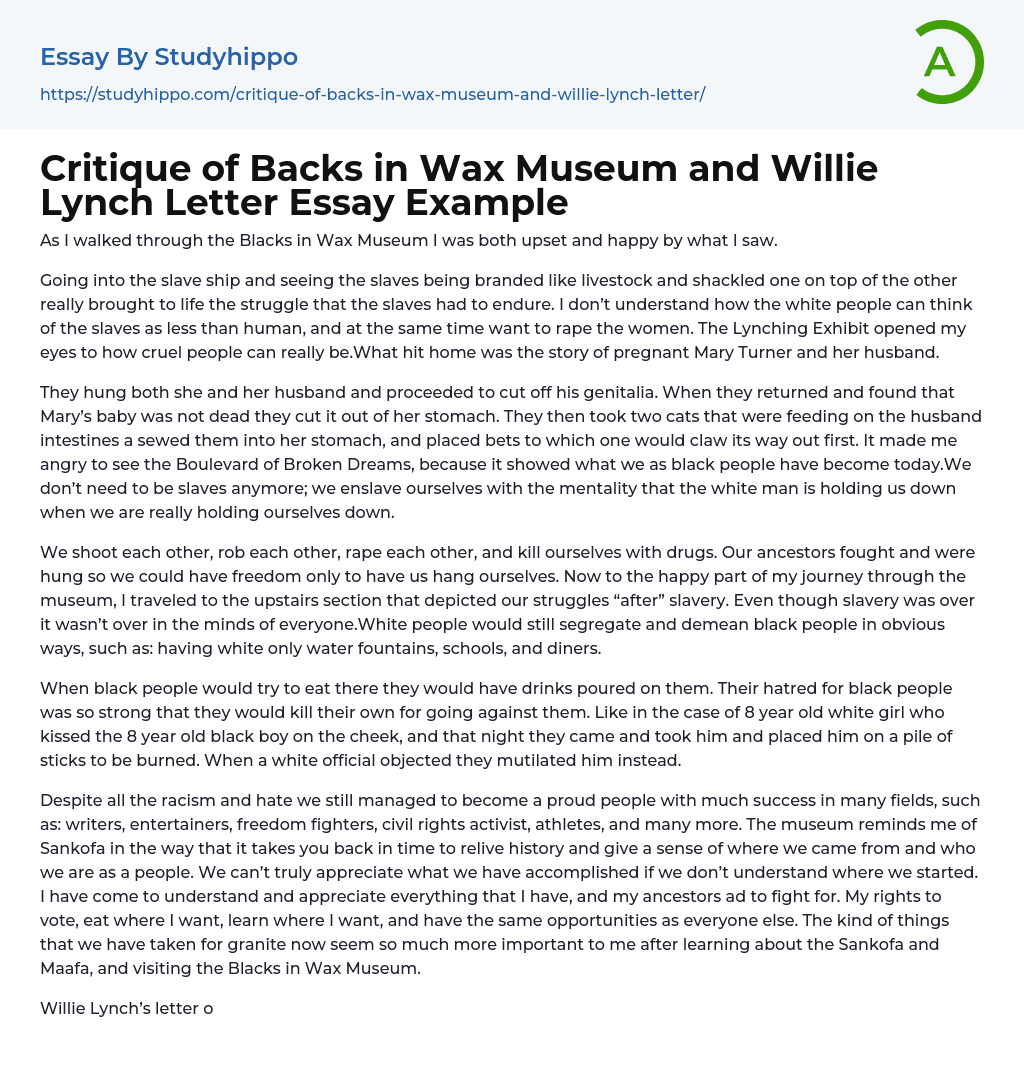

Critique of Backs in Wax Museum and Willie Lynch Letter Essay Example
My emotions were a mix of sadness and joy as I toured the Blacks in Wax Museum.
Witnessing slaves being branded like livestock and shackled together in the slave ship truly illustrated the hardships they endured. It's unfathomable how white people could view them as subhuman and still desire to sexually assault the women. The Lynching Exhibit unveiled the extent of human cruelty, particularly in the heartbreaking account of Mary Turner, who was lynched while pregnant with her husband.
Mary and her spouse were executed, with the man's genitals being severed. Although Mary's child was believed to have perished, it was discovered alive and removed from her womb by force. The husband's intestines were devoured by two felines before they were sewn into Mary's abdomen, with wagers placed on which creature would emerge first. The sight of the Boulevard of Broken Dreams i
...ncites fury within me due to its depiction of the current state of African Americans. We must reject the notion that we are held down by white individuals, as it is our own self-imposed limitations that hinder us. It is imperative that we recognize our freedom and refrain from enslaving ourselves.
Despite our ancestors fighting and being hung for our freedom, we still shoot, rob, rape, kill ourselves with drugs and hang ourselves. The museum's upstairs section portrays our struggles after slavery. Although slavery was no longer enforced, not everyone accepted this. White people continued to segregate and belittle black people in demeaning ways, such as providing white-only water fountains, schools, and diners.
Previously, black individuals faced extreme animosity that led to the deprivation of fundamental privileges, such as entry to specific facilities. Moreover, they
encountered vicious assaults and fatalities for minor wrongdoings. An infamous occurrence involved an 8-year-old Caucasian girl and a black male who shared a kiss on the cheek resulting in the boy being subjected to immolation on top of sticks as punishment. This aggression was not limited to African Americans since even white authorities who opposed it were frequently targets of brutalities.
Although people of color have encountered racism and animosity, they have accomplished remarkable feats in writing, entertainment, activism, and athletics. Similar to the Sankofa museum experience where we revisit our history to appreciate our identity, our journey entails comprehending our past to fully value achievements such as equal voting rights, education access, and opportunities. The Blacks in Wax Museum highlights defining moments of Sankofa and Maafa that aided me in recognizing my ancestors' struggles. Therefore, I acknowledge fundamental privileges often overlooked.
Willie Lynch believed that he could gain control over slaves by pitting them against each other, but his plan underestimated the intelligence and loyalty of Africans to one another. Despite Lynch's efforts to compare breaking a slave to breaking a horse, the slaves realized that their true enemies were the slave owners, not their fellow countrymen.
Although the idea of treating slaves like animals may seem plausible, it is important to note that they are not. While using kindness and affection to train a horse can result in a docile animal, subjecting a slave to cruel methods such as torture and being coated with tar would only lead to fear and rebellion. Witnessing a male slave being viciously beaten in front of her could cause a woman to take drastic measures, such as attempting to secure
her child's safety or even considering infanticide due to concern for their future living conditions. Even if she managed to keep her child with her, her influence alone would not be enough for ensuring proper development and upbringing.
According to Willie Lynch, the child's thoughts and emotions are influenced by those around him, including those who have an impact on him. Lynch believed that due to his racist beliefs, Africans could be trained like animals and manipulated for his purposes. He thought that slaves forcibly taken from their families would trust their captors over other Africans. As part of his strategy, Lynch suggested dehumanizing them so much that they lose any connection with their original culture and only identify with the new one provided for them.
It is unfortunate to acknowledge that some negative remnants of slavery still persist among proud African people today. There are instances of violence and theft that occur over material possessions such as shoes and money, as well as instances of women being sexually assaulted by members of their community instead of being supported. Additionally, there are cases where individuals show disdain towards women with lighter skin and "good" hair which creates internal division.
Some of us continue to abide by the slave mentality that was instilled in us by our former owners, resulting in destructive behavior toward one another.
- Slave Trade essays
- Black People essays
- Abolitionism essays
- Adam Smith essays
- American History essays
- American Revolution essays
- Ancient Egypt essays
- Articles Of Confederation essays
- Atlantic Slave Trade essays
- Aztec essays
- Benjamin Franklin essays
- Civil Rights Act of 1964 essays
- Civil Rights Movement essays
- Civil war essays
- Cleopatra essays
- French And Indian War essays
- Gettysburg essays
- Great Depression essays
- Hurricane Katrina essays
- Industrial Revolution essays
- Jamestown essays
- Manifest Destiny essays
- Mccarthyism essays
- Patrick Henry essays
- Pearl Harbor essays
- Pocahontas essays
- Prohibition essays
- Pyramids essays
- Salem Witch Trials essays
- Slavery essays
- The New Deal essays
- Thirteen Colonies essays
- Westward Expansion essays



